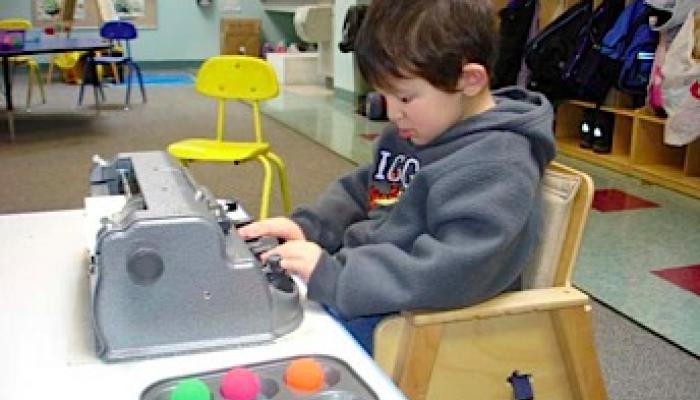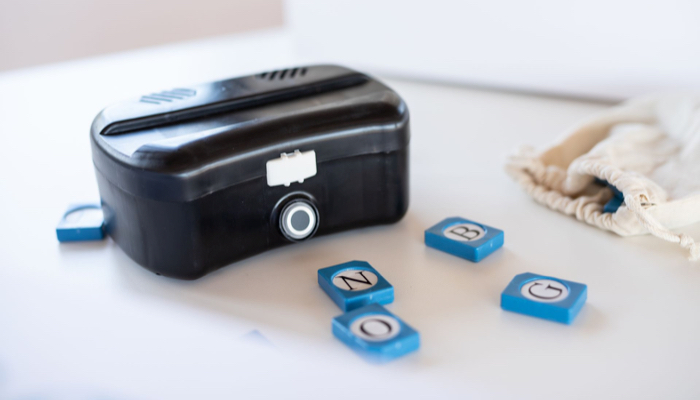Thoughts from a Kindergarten Teacher About Welcoming a Blind Student to Class

By Michelle
One of our MAPS moms, Michelle, interviewed her son’s kindergarten teacher. Michelle’s son, Matteo, is blind and has bilateral anophthalmia. Here are the answers from Nancy Kulis, a teacher at Mary Rowlandson Elementary School in Lancaster, Massachusetts:
What thoughts did you have when you first learned you would have a child who was blind in your classroom?
At first I didn’t think too much about the whole situation, because I had previously worked 6 years as a special needs aid with a child who is legally blind. I felt I had at least a little experience within the field and had so enjoyed the special friendship I developed with this child and her family over the years. I had also worked with an Optelec Machine and a vision specialist before and had implemented modifications and accommodations when necessary.
When I realized that the child in my classroom had anophthalmia and had two prosthetic eyes, that’s when I got a little nervous. Thinking about no light perception and the thought that an Optelec type machine would never be an option I started to wonder how I would ever be able to teach Matteo.
My next concern was with his communication difficulties. Would I be able to understand him? Would I remember how to say things? I had to change my language to be sensitive to his needs (ie: “Turn your body towards my voice,” “Hi, Matteo, it’s Mrs. Kulis on your right,” and no more “1, 2, 3, eyes on me!”)
Once school got started and you got to know Matteo, were things different than you expected?
I was fortunate to meet Matteo early on. I had met both the vision specialist and Matteo in the early spring during an Orientation held at the school. I stopped into the school several times during the summer while he was attending summer school and spoke to both he and his aid. I think this helped with transitioning once school actually started.
As I got to know Matteo, it became a little easier to understand him. It was necessary to use context clues, his voice intonation and information from mom, but these are all strategies that helped me. As far as remembering how to say things, the more I did it, the easier it was. I had to remember that this was a learning experience for all of us.
What did you do to prepare your classroom for Matteo?
We had a team meeting to prepare many of us who would be working Matteo. We were taught and got to practice how to lead Matteo; we also learned how to approach and talk with him. Matteo’s mom had sent me some pictures of his summer kayaking experiences. Bingo! We had a connection! I too love to kayak! I made a little PowerPoint presentation which I forwarded to his mom and then I put it in book formation and titled it, Matteo’s Summer Vacation.
This book helped when introducing Matteo to his classmates. His mom also wrote a letter introducing him to our school. This letter was included in our Orientation packages for all Kinders and their parents, as we felt the information was valuable for all.
We made the following special provisions for him: a cubby close to the door, a mail box at just the right location, open and unobstructed pathways, audible signals such as a train whistle and chime, brailed name plates for cubby/mailbox/center tables, etc.
What things would you have liked to have known before Matteo started school?
We met Matteo early on and I feel that we were fully prepared. It would have been reassuring to know that the vision specialist would meet with me weekly to go over lesson plans and make the necessary modifications and accommodations we needed.
What have you learned from having Matteo in your class?
I have learned that it is best to explain things fully to the other parents and children so they know what to expect. This allows all to be very accepting of Matteo and his challenges. Many of the tactile strategies that are utilized with Matteo are beneficial to others children as well.
What advice would you give to a teacher who was going to have a child who is blind in their class for the first time?
You can’t do it alone! Accept and work with all team members. Try to show that even though the child is blind he or she is still a person with true feelings.
As with Matteo, he can kayak and ski just like you and me! And, boy oh boy do we know that he loves music! God Bless America is a favorite of his!
Don’t be afraid to do something for this child that is different than the other children. Explain how he sees with his hands and you see with your eyes. A true example of this is our classroom birthday celebration. We usually have each child draw a birthday picture for the birthday child and it is put into a book formation.
For Matteo, we took little glass marbles and made birthday wishes on them. We placed our marble wishes into a little snowman drawstring bag for Matteo to always have and cherish.
Before other children try to mother a child who is blind, try a group discussion and ask the visually challenged children if they want help or if they want to do it themselves. Props for stories are very helpful too.
Related Posts

IEPs
What Should I Bring to My Child’s First IEP Meeting?
Prepare for your child's first IEP meeting with confidence! Discover exactly what documents to bring, including educational records, medical info, and questions to ask.

Visual Impairment
The Gift of Understanding: How a Young Child Helps His Blind Father Navigate Life
When a parent is blind, it’s natural for people to wonder how their sighted child will adapt. Will they struggle to understand their parent’s needs? Will they feel burdened by...

Braille and Literacy
Making Braille Fun: Introducing Handi Exceller’s Innovative Learning Tools for Blind Students
Handi Exceller was born from a simple idea: learning braille should be both fun and accessible. The company creates interactive and gamified ways to teach braille.